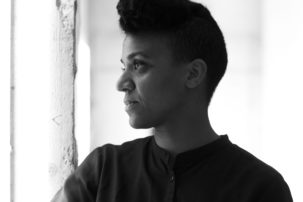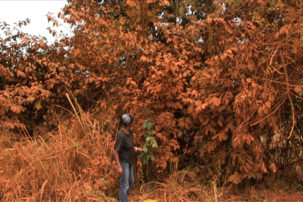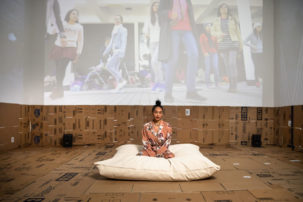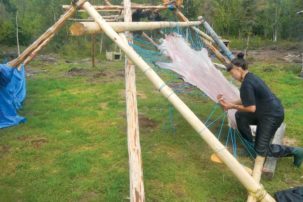After I congratulated Kapwani Kiwanga for winning the Sobey Art Award last night, I told her that even though I identify as a critic who doesn’t write about artist’s practices, her practice is the one I’ve written about the most this year. “You talk more about institutions and the structures around the work,” she added. “Exactly,” I said, and that’s exactly what Kiwanga’s site-specific installation works tend to do. She’s based in Paris and got her start showing in Europe, but this year, several Canadian exhibitions have laid bare how the insidious apparatuses of design and architecture control marginalized bodies.
The first time I wrote about her work, I examined the response to her exhibition “A wall is just a wall (and nothing more at all)” at the Esker Foundation in Calgary. Her installation pink-blue, which premiered at a solo exhibition at the Power Plant the year prior, had broken the Esker’s attendance records because teenagers rushed in to take selfies in the work’s super selfie-able bisexual lighting. Écorché examined archival blueprints for Alberta hospitals and magnified a cross-section of their walls with the construction materials used to build them; one of the sculptures draws from architectural plans for Alberta’s largest and most notorious psych ward, a hospital that for much of the 20th century had connections to the eugenics movement. Another work, Jalousie, was a room divider with two-way mirrors mimicking the window coverings that allowed colonizers to watch and not be seen.
The second time, I observed the audience response to her work in Joliette, Quebec. The exhibition’s centrepiece was Kiwanga’s excavation of a rectangle of dirt outside the gallery: she sterilized the dirt and placed it in a mound along the middle of the space inside, and invited viewers to use a clay scoop to place some of the dirt in a clay pail and to return it to where Kiwanga had removed it, gesturing toward attempts at repatriation.
When Kiwanga accepted her $100,000 award, she said she came to the National Gallery of Canada as a child but never envisioned herself in this position. Over the course of our conversation, several women interrupted us. The chair of a foundation told Kiwanga, “I was amazed at how calm you were.” Another woman told her she should’ve taken a selfie onstage, and Kiwanga responded, “But I’m a luddite. I don’t even have Facebook.” Still, we managed to discuss strategies for critique, the differences between audience reception of her work here and in a European context and what white press sometimes gets wrong about her work.
Merray Gerges: The very standard way to do this interview is to begin by asking you how you feel…
Kapwani Kiwanga: I feel like we have to keep on talking. And doing. But talking is for me sometimes the beginning of doing.
MG: That’s one of your visual strategies that compels me: you’re not actually issuing a call to action. You’re highlighting what needs to be acted upon in these very subtle ways, because what you’re pointing to is in itself insidious.
KK: For me, it has to be in these subtle strategies: […] throwing a ball in flames, like an accelerationist position or whatever position it might be—that’s one way, but that’s not my way. I want to work in deeper micro-shifts. Maybe it’s long-term, maybe it comes and goes, but diversity of tactics is the way to go.
MG: I’m curious to hear the differences you’ve noted between responses to your work from Canadian audiences and European audiences.
KK: I feel generally that there’s a critical analysis that’s more developed here, which is beyond just a formal lens. Even when people are apprehensive or when they challenge it, they tend to be more bienveillant—they’re more caring and kind—even when holding conversations about difficult subjects. It’s a hard question.
MG: How does that difference in audience bear on how you make work?
KK: I don’t strategize so much. I respond to a space: what will happen is that I’ll come to a place and I want to know the history of the place that I’m showing in. It doesn’t always inform the work but I need to know where I’m standing. So that’s the start. And then I attend to the physical response, and what the audience is going to experience. And I might translate language or translate form: I think, maybe this will resonate more, to make an opening with an element that is local so people can enter into it. There are always conversations with curatorial teams that will bring stuff up.
MG: I’m curious about the difference in audience reception to your work and how that affects how you make your work, because when I went to Berlin for this year’s biennale I had conversations with many people of colour who told me that people in the art world there are finally starting to have this conversation about decolonization, but European institutions are not invested in any kind of decolonial activity beyond au courant theory. I will be the last person ever to congratulate Canada, but I feel like we are having these conversations in the art world here—even if how we’re having them is imperfect.
KK: I would say so, too. We have some really radical people and collectives and artist-run centres that don’t care about the institution, that are thinking about how to make art or how to have a conversation [without the institution]. But decolonizing is a buzzword we see a lot these days. It’s in Europe but it hasn’t been embraced so much by the institutions themselves—it’s from the outside. Whereas here, it’s reluctant and it’s hostile but it feels like people are still welcomed around the table. How that really plays out is something else, though.
MG: I really want to know what you feel people get wrong when they write about your work.
KK: I mean it’s not wrong—it’s a position. I don’t know. Everyone has a place they’re coming from. Maybe what people get wrong: the fact that I’m interested in Africa and African diaspora and that’s sometimes put ahead when it’s not necessarily the only thing. Essentializing happens sometimes.
MG: I’m basically asking you: what do you feel is fucked up about how white press covers your work. Where to begin?
KK: Sometimes it’s okay. They’ll say it’s about identity and postcoloniality, but “postcolonial” is not a word I would ever use. I have never used that term. Labelling it that way can negate a lot of things. That “postcolonial” label essentializes part of my origins. It’s taxonomy. And we know what that does.
MG: Which is exactly what your work is interrogating.
KK: Yes, and knowledge-creation—any structure that creates, that allows us to where we got to. How did we get here? Let’s go back and see. The structures that enabled it are clear.
MG: What’s next?
KK: A show at MIT in February looking at surveillance and anti-Blackness, and around [The Negro Motorist] Green Book—a guidebook created by African Americans for how to travel safely around the States during Jim Crow. I’m influenced by Simone Browne’s Dark Matters: [On the Surveillance of Blackness]. I’m looking at the impetus behind surveillance technology: it’s the same but what it looks like has changed.







